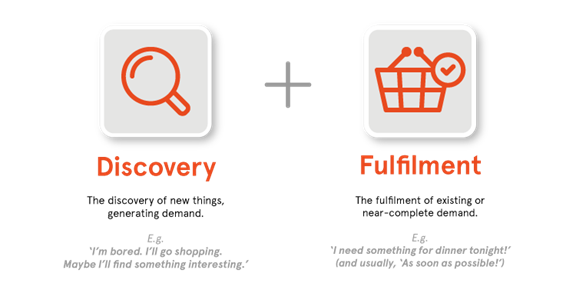As mobile continues to transform the world, fundamentally altering what customers expect and how businesses operate, many established retail businesses and approaches are in a state of flux - or facing imminent disruption.

A perspective on retail digital transformation
At Kin + Carta, we have already helped a number of retailers, including Argos, Homebase (Bunnings), Debenhams and others address the pressing challenges mobile and disruption present. However, to us, it still feels like there is a huge seam of as yet untapped potential ahead, and unparalleled opportunity to create truly transformative new retail products, services and experiences.
In an upcoming series of posts, I am going to unpack the opportunities and challenges for retail digital transformation, but in this first post, let’s briefly establish the wider context.
The big picture: the traditional retail ‘funnel’ continues to fragment.
It is worth remembering how much is actually covered by the word ‘retail’: from big supermarkets to online-only retailers, one-off boutiques, ‘brand experiences’ and giant out-of-town stores - all of these different experiences and businesses fall under the broad church of ‘retail’. Their diversity, and the differences in scale, can make it a complex area to discuss in general terms. One way to cut through this, however, is by identifying the two key jobs that ‘retail’ tends to help customers achieve:

For most of the 20th Century, ‘retail’ tended to serve both of these jobs in the same place - a shop (or sometimes a catalogue, or even a TV channel). Particular retail businesses and product verticals might have weighed more heavily toward one of the two jobs above, but they were usually conjoined in the same sales and marketing ‘funnel’. Generally it followed the pattern that (1) a retail experience (2) set up the sale. However, in our increasingly digitised and mobile-enabled world, these two have uncoupled (consciously or otherwise).
Of course, the fundamentals for most retail businesses have stayed the same - getting the sale is still the name of the game. Customers, however, no longer need to discover, find and buy in the same place. They can do them all quite separately - online or off, on a mobile site or an app, and in any number of different ways.
This accounts for the unease among retailers, for example, when customers exhibit ‘show-rooming’ behaviour. For example, a high street retailer invests heavily in an in-store experience to drive demand generation. However, this fails to follow through with fulfilment, because the potential customer finds a better way via mobile - usually at a better price, or a more convenient fulfilment method for them.
These emergent mobile behaviours are driving critical changes on our high streets as businesses that fail to adapt quickly lose the sales they need to survive - and simply vanish.
However, it is not all doom and gloom. There is great potential for both discovery and fulfilment through mobile. The imperative for all retail businesses now is to keep experimenting, adapting and improving to meet the challenges of this fundamental shift.
With this in mind, and to conclude this initial retail digital transformation post, here are three ideas (and some pitfalls to avoid) for anyone looking to build a stronger retail business this year and beyond.
1. Don’t go chasing trends
Customer service staff, large department or ‘brand experience’ stores all implicitly or explicitly exist to help us uncover the things we might need or like, and make us aware of new things we didn’t know about before.
This is the extrovert part of retail, and it is often the target of ‘digital marketing innovation’ - often employing whatever technology is the current zeitgeist. This year, it will probably be VR. The reality of this emergent world is that nobody is entirely sure what works just yet, and even less sure of what will work for a particular group of customers in a given category. So, beware those that peddle ‘innovation’ without connecting it to the fundamentals of business, and without the smarts to scale things beyond an eye-grabbing trial.
2. Get back to the frontline
Healthy scepticism aside, there are huge emergent opportunities to augment and transform what ‘going shopping’ means - whether through mobile, online or in physical stores. The key to finding what works, however, isn’t betting the farm on a ‘digital innovation’ idea that you hope the customers will like. It is about putting lightweight tests on the frontline to uncover existing and emergent needs.
Look at Waterstones. The solution to turning around what looked like a terminal decline in physical book retail, wasn't digital marketing innovation. Instead, they rooted their approach in handing power back to local teams. From store layouts to recommended reads, this capitalised on frontline staff’s folk-knowledge, and applied it to the customer experience. Waterstones were, in turn, one of the few rays of light in a dismal winter for retail results.
3. Escape head office isolation
The key takeaway for all retail businesses should be to move away from centralised directives dreamt up at head office (or the agency brainstorm). Instead, discover what customers want by getting out into the wild, rapidly experimenting and piloting ways to improve the customer experience based on observations of current behaviour.
If customers linger near products and seek-out staff for assistance, for example, start exploring how mobile might help customers summon help more quickly. Consider, too, what could be put in the hands of staff to make their advice more valuable. Similarly, if customers move slowly, and feel or inspect products with great care, then experiment with new ways to help convey the experience and feel of a product in the digital realm, or in a more cost efficient way than large stores full of products.
---
Stay tuned for part 2 of the series as we unpack one of the two key jobs that retail helps customers achieve: fulfilment, including a look at payment considerations.